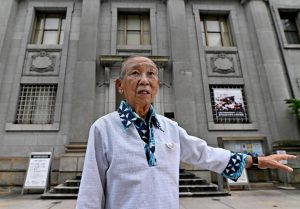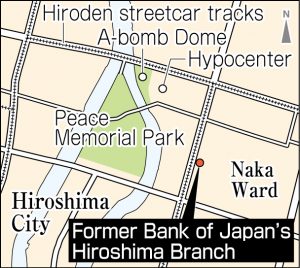Memories engraved in A-bombed buildings, Part 6: Former Bank of Japan’s Hiroshima Branch
Jul. 26, 2024
Hope for permanent preservation of ‘silent witness’
by Minami Yamashita, Staff Writer
September marks one year since renovation work was completed on the former Hiroshima Branch of the Bank of Japan, located in the city’s Naka Ward. “There are scars here, too. But the building is too beautiful now,” said Yasuhiro Nanba, 85, a resident of Hiroshima’s Asakita Ward. Mr. Nanba can explain each and every scar left on the bank by the atomic bombing. While working as a security guard at the building, he collected testimonies on his own of the atomic bombing from those affected and compiled them into a publication 20 years ago. He serves as a kind of spokesperson for the ‘silent witness’ that is the A-bombed building.
During the war, Mr. Nanba experienced air raids on his hometown of Okayama City. He also lost his beloved uncle, who died carrying out a kamikaze attack. “I was always thinking subconsciously about the war.” Post-war, he started work at a local bank and, through the training process, learned of the existence of the former Hiroshima Branch of the Bank of Japan. Hearing of the situation after the atomic bombing, he was shocked by the fact that the bank had resumed operations only two days after the bombing. Once aroused, his interest continued to smolder under the surface.
Served as guide in bank security guard uniform
After being in charge of sales and loans, he took early retirement in his late 40s and moved to Hiroshima City at the invitation of a company where his acquaintance was working. After he turned 60, he changed jobs again and started work for a security company because, in 2000, the Bank of Japan started to lease its former Hiroshima Branch to the Hiroshima City government free of charge, and with that the branch was opened to the public for display. His family opposed his decision, but he persuaded them by explaining, “If I’m a security guard, I will always be in the building.” His wish came true, and he was put in charge of the Hiroshima Branch’s security.
According to Mr. Namba, “I tried to look into things, but I couldn’t identify the traces left by the atomic bombing.” Just as he was growing disappointed, former bank employees who had experienced the atomic bombing visited the bank and provided him with detailed explanations. They showed him depressions in the floor made by desks blown by the A-bomb’s blast, marks on the walls pierced by shattered window glass, and more. Before he knew it, he began to show visitors around the building in his security guard uniform. “I was scolded by the company and told to just do my job,” laughed Mr. Nanba as he explained that time.
On his days off, he would visit former bank employees and bereaved family members both inside and outside Hiroshima Prefecture to whom he had been introduced, as well as collect and compile information on the situations faced by the 95 employees of the bank at the time of the bombing. Based on new testimonies and personal accounts for which he obtained permission for reproduction, he self-published Machi ga Kieta Hi (in English, ‘The Day Hiroshima Disappeared’) in 2004 and Kieta Dento no Oto (‘The Sounds of Lost Traditions’) the next year, in 2005. The former was a collection of personal accounts of 31 employees of the Hiroshima Finance Bureau, located on the third floor of the bank, and the latter was a collection of personal accounts of 28 branch employees. With donations from the bereaved families, Mr. Nanba distributed his books free of charge to schools that visited the bank for their peace studies curriculum.
A woman staff member who experienced the bombing at the Hiroshima Finance Bureau and was seriously injured wrote, “As the bank was extremely sturdy, it appeared as if nothing had happened when looking at it from the outside. I viewed it with the realization I survived because I was in such a building. It’s an indescribable feeling.”
Mr. Namba revealed that several of the testimonies could not be included in the publications. One woman recalled scenes she witnessed the day after the atomic bomb was dropped. She thought she saw a mother holding her baby committing suicide by jumping from the roof of the branch building. However, when looking more closely, she realized it was not a baby she was holding but a pillow. Mr. Namba said, “The woman who committed suicide probably went mad. It was too cruel.” Tears still well up in his eyes when he considers the devastation at that time.
Like a living thing
It has been a long time since Mr. Namba retired from his job as a security guard at the branch. But when he gets the chance he still visits the bank several times a year. He said, “I feel this building is like a living thing that has experienced both happiness and hardship. I’m amazed the building survived the atomic bombing.” Pointing to the scars that remain from that day, he said, “I hate war,” adding “I hope the building is preserved permanently so that what happened here will be engraved into history.”
Keywords
Former Hiroshima Branch of the Bank of Japan
Completed in 1936, the ferroconcrete building is composed of three floors aboveground and one basement floor, with a total floor space measuring 3,214 square meters. The building’s architectural style features a classical style, including Greek-style ornamental carvings. The bank is located 380 meters from the hypocenter, and according to the Hiroshima City government, eight bank employees who were in the building and 12 workers at the Hiroshima Financial Bureau on the third floor died in the bombing. The third floor was incinerated, while the first and second floors, whose shutters were closed, escaped major damage. The bank vaults in the basement were spared damage. In 2000, the building was designated an important cultural property of Hiroshima City. The city government now uses the building as a venue for cultural and artistic activities for members of the public.
(Originally published on July 26, 2024)









